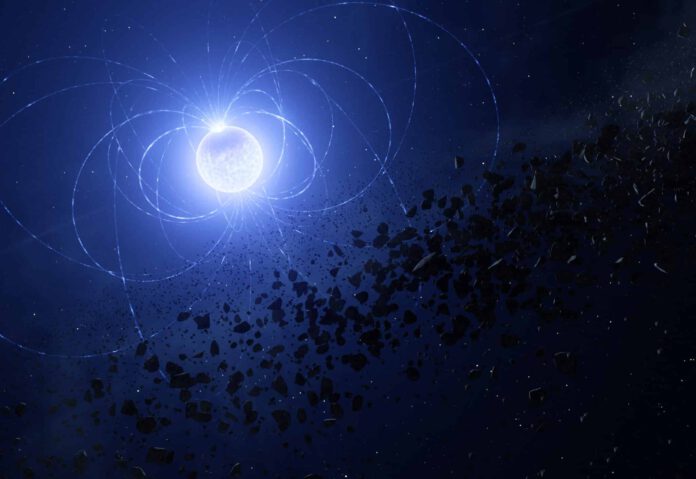
White Dwarfs Devour Planets
This is not the onset of a macabre fairy tale, but a known phenomenon in the universe. For the first time, researchers have found evidence of this process, marked by a metallic scar.
White dwarfs are the slowly cooling remnants of stars, much like our Sun. Toward the end of their existence, they begin to swallow the surrounding planets, hence their nickname “cannibal stars”. This is no new insight. However, what is new is that scientists now finally understand how this process occurs. The star’s magnetic field plays a key role, hence the occurrence of a scar on its surface.
The Section for Observation with the Very Large Telescope (VLT)
This revelation was discovered by astronomers using the European Southern Observatory’s (ESO) Very Large Telescope (VLT) in Chile. They zoomed in on the surface of the white dwarf WD 0816-310. This remnant, which is currently about the size of Earth, originated from a star similar to our Sun, albeit slightly larger.
The scar found on its surface by researchers is made up of metals brought in from a planetary chunk about the size of Vesta, the second largest asteroid in our solar system with a diameter of around 500 kilometers. When planets or asteroids approach a white dwarf, they break apart and form a debris disk around the dead star. Part of this is swallowed up by the star, leaving traces on its surface.
The visual image portrays a white dwarf swallowing up planetary fragments.
Uneven Distribution
The question is how the star acquires this metallic scar, as it was presupposed that this material would be distributed evenly across the surface. However, this is not the case. According to observations, the intensity of metal detections fluctuates during the star’s rotation. These variations are in sync with changes in the white dwarf’s magnetic field. This indicates that the metals have accumulated in a certain area of the white dwarf, close to one of its magnetic poles.
There is clear evidence that the magnetic field guided the metal toward the star and created the scar. The accumulation of metals is held in place in the same way that the magnetic field channelled the plummeting planetary fragments to the star’s surface.
Contrary to Prevailing Theory
These observations counter the current theory. Astronomers had previously observed white dwarfs with metals spread across the surface. These were believed to have originated from planets that came too close to the star and followed a trajectory similar to that of comets. However, the situation is different with the examined white dwarf. The evaporated material was driven to the magnetic poles by the dying star’s magnetic field.
“We’ve never seen this before,” said one of the researchers. They used FORS2, a special instrument of the VLT, to observe the metallic scar and accurately measure the magnetic field. This enabled them to conclude that this magnetic field caused the metal to accumulate, forming a kind of scar.
This is a remarkable discovery that provides further information about the composition of exoplanets. It also demonstrates that planetary systems remain dynamically active even after their death, as the researchers describe.











